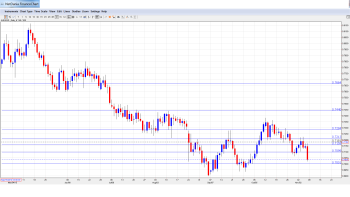AUD/USD posted losses for a fourth straight week, losing 100 points. The pair closed at 0.7035. This week’s key events include NAB Business Confidence and Employment Change. Here is an outlook on the major market-movers and an updated technical analysis for AUD/USD.
The US dollar was broadly higher following the Non-Farm Payrolls report, which more than beat expectations, with 271K jobs gained and a 2.5% y/y gain in wages. This outstanding release points to a strong labor market, and certainly keeps the December rate hike option wide open. The RBA kept rates at 2.00%, but noted that a rate cut remains on the table.
[do action=”autoupdate” tag=”AUDUSDUpdate”/]
AUD/USD graph with support and resistance lines on it. Click to enlarge:
- Chinese Trade Balance: Sunday, 2:09. The Australian dollar is sensitive to key Chinese releases such as Trade Balance, as China is Australia’s number one trading partner. The trade surplus rose to $393 billion in October, easily beating the estimate of $367 billion.
- ANZ Job Advertisements: Monday, 00:30. This indicator provides a snapshot of the strength of the labor market. In September, the indicator jumped 3.9%, its biggest gain since June 2014. This marked the indicator’ third gain in four months.
- NAB Business Confidence: Tuesday, 00:30. This indicator, released monthly, is a key event. The indicator posted a strong improvement in September, rising to 5 points. Will the upward trend continue in the October report?
- Home Loans: Tuesday, 00:30. Home Loans provides a snapshot of the level of activity in the housing sector. The indicator posted a strong gain of 2.9%, but this was well short of the estimate of 4.9%.
- Chinese CPI: Tuesday, 1:30. Chinese CPI dipped to 1.6% in September, shy of the estimate of 1.8%. The downward trend is expected to continue in the October report, with an estimate of 1.5%.
- Westpac Consumer Sentiment: Tuesday, 23:30. Analysts keep a close eye on consumer confidence indicators, as consumer confidence often translates into consumer spending, a key driver of economic growth. The indicator rebounded in October, with a strong gain of 4.2%.
- Chinese Industrial Production: Wednesday, 5:30. The indicator dropped to 5.7% in October, compared to 6.1% a month earlier. This reading also missed the estimate of 6.o%. The markets are expecting more of the same, with an estimate of 5.8%.
- MI Inflation Expectations: Thursday, 00:00. This indicator helps analysts predict actual inflation readings. The indicator improved in September, rising to 3.5%.
- Employment Change: Thursday, 00:30. Employment Change is one of the most important economic indicators, and can have an immediate impact on the movement of AUD/USD. The indicator surprised with a decline in September, marking the first decline since April. The markets are expecting a strong turnaround, with a forecast of 15.2 thousand. The unemployment rate is expected to remain steady at 6.2%.
* All times are GMT.
AUD/USD Technical Analysis
AUD/USD started the week at 0.7133 and climbed to a high of 0.7224. The pair then reversed directions sharply and dropped to a low of 0.7022, as support held firm at 0.7000 (discussed last week). The pair closed at 0.7035.
Live chart of AUD/USD: [do action=”tradingviews” pair=”AUDUSD” interval=”60″/]
Technical lines from top to bottom:
With the pair posting sharp losses, we start from lower levels:
0.7440 capped the pair back in August, and remains key resistance.
0.7284 is the next resistance line.
0.7160 has switched to a resistance role and is a weak line.
The round number of 0.7100 is providing support.
The very round level of 0.70 worked as a cushion in August and is the next support level.
0.69 has provided support since September.
0.6775 has provided support since March 2009.
The final support line for now is 0.6623.
I am bearish on AUD/USD
The US posted an excellent NFP release on Friday, meaning that a Fed rate hike is more likely in December. This is a positive development for the US dollar, and the Australian dollar, which has lost some 350 points in the past month, will have a tough time stemming the US dollar rally.
In our latest podcast we explain how to trade the euro printing machine:
Follow us on Sticher or on iTunes
Further reading:
- For a broad view of all the week’s major events worldwide, read the USD outlook.
- For EUR/USD, check out the Euro to Dollar forecast.
- For the Japanese yen, read the USD/JPY forecast.
- For GBP/USD (cable), look into the British Pound forecast.
- For the Canadian dollar (loonie), check out the Canadian dollar forecast.
- For the kiwi, see the NZD/USD forecast.

